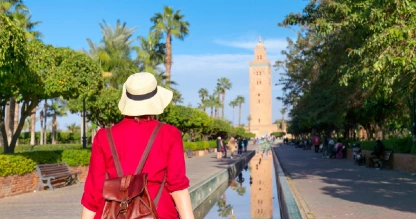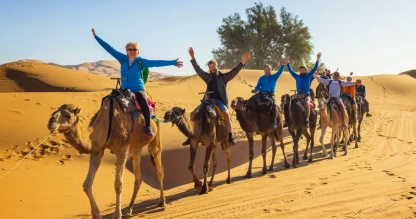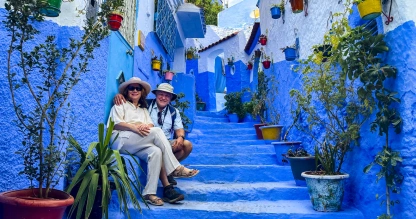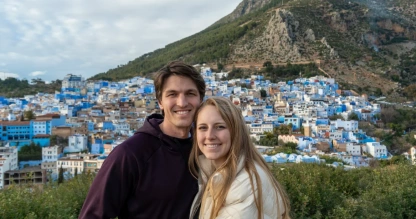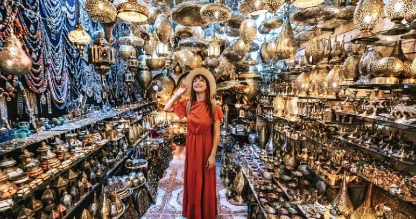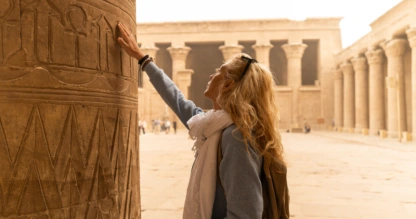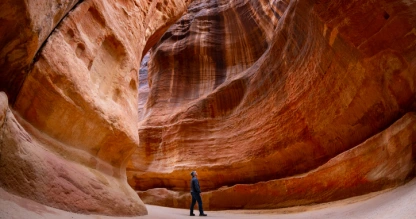
Ultimate Marrakech Guide
Marrakech, the first imperial city of Morocco, is an exceptional blend of history, architecture, and living heritage. Founded by the Almoravid dynasty in the 11th century, it has been a major political, economic, and cultural hub for nearly a millennium.
Listed as a UNESCO World Heritage site, the medina houses exceptional medieval Islamic architectural examples, including the dominating Koutoubia Mosque. Among the top things to do in Marrakech during your Morocco tour are exploring Jemaa el-Fna square, strolling the old souks, and touring the Menara and Agdal gardens. Visit in spring or autumn for the best experience.
Encountering the Unusual Duality of Urban Morocco
A first glimpse of Marrakech reveals a city in which ancient Islamic urban design clashes with modern life. Motorbikes echo off centuries-old walls in the medina, leading to peaceful alleyways untouched since Almohad times. The blend of past and present is what makes the Red City fascinating to tourists and scholars alike.
Marrakech: A Living Dialogue Between Eras
The first introduction to Marrakech reveals a stunning intersection of time and space, where centuries-old Islamic urban planning blends with the dynamism of modern life. Within minutes, visitors experience the contrast of motorbikes weaving through narrow, winding alleys beside serene riads and quiet courtyards unchanged since the 12th century. This unique layering of past and present defines the Red City’s enduring appeal to curious travelers and scholars alike.
A City of Architectural Dialogue
Marrakech is an energetic treasure trove of urban evolution. Founded by the Almoravid dynasty around 1070, it quickly became a great imperial capital and has remained a leading political, economic, and cultural center for nearly a millennium. Ringed with rose-red ramparts built during Almohad times (circa 1120s), the medina covers a vast expanse of old-fashioned riads, mosques, and bazaars.
Outside of the walls is Ville Nouvelle, constructed during the French Protectorate (1912–1956). Broad boulevards, Art Deco architecture, and European-style cafés define this quarter in an abrupt contrast with the crowded urban center of the medina. Today, the quarter is a thriving modern cultural hub with Moroccan ingenuity blended with the world's influence.
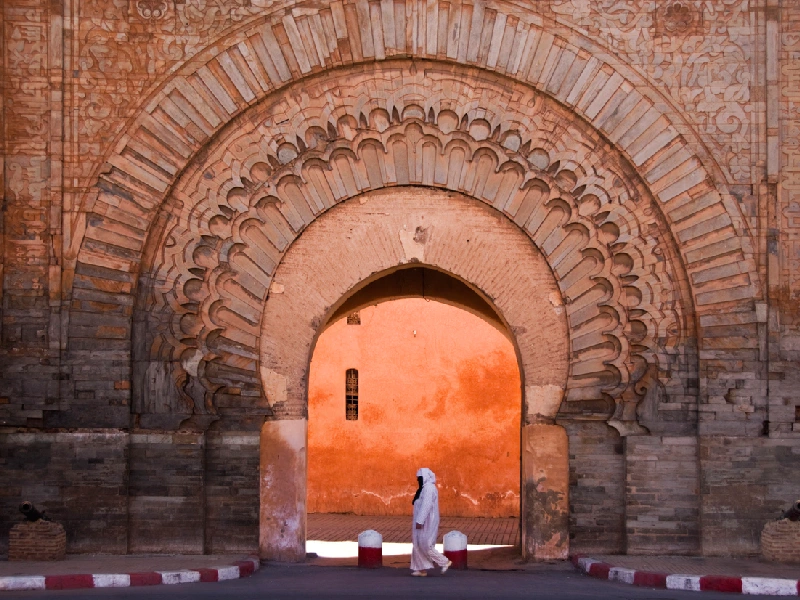
Decoding the Medieval Urban Matrix
The winding layout of the medina follows the natural principles of historic Islamic urban planning, refined over centuries of development without geometric logic. Its tight, curved alleyways make it hard to find your way, challenging strangers to enjoy discovery.
Throughout the souks, the merchants and artisans are still divided by trade, leather workers, metalworkers, spice merchants, following a medieval guild system.
To assist travelers in this ancient maze, visitors are encouraged to:
- Secure goods, especially in heavily populated market areas
- Go early morning or late afternoon to avoid more people
- Enjoy becoming "lost" as part of the experience and use maps only when necessary
Cultural Rhythms and Living Traditions
Everyday life in Marrakech is a commentary on traditions deeply rooted. Moving around in the medina is less structured than in Western cities, there is no strict traffic code, but there is a shared social sense that choreographs the movement. Traditional café culture, historically male-dominated, still holds older social behaviors, though this is gradually changing as venues become more inclusive.
The "inshallah" (God willing) mentality of thinking constructs the understanding of time, valuing flexibility and the will of God over timetables. The cultural mindset tends to be a shock to guests but then warmly welcomes a more relaxed, contemplative travel pace.
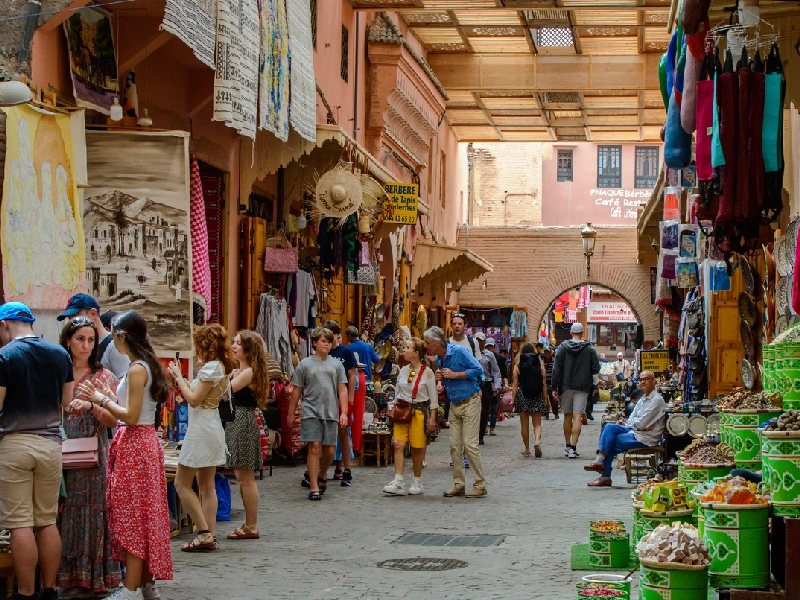
Cultural Treasures and Sensory Discoveries
The labyrinthine medina conceals architectural masterpieces and cultural heritage that have evolved uninterrupted since medieval times. Each experience yields layers of historic significance, ranging from ancient commercial tradition to palace-era artistry that continues to perplex scholars and visitors in equal measures.
The Living Theater of Jemaa el-Fnaa
Jemaa el-Fnaa is Morocco's most stereotypical cultural amphitheater, in which centuries-old oral culture is acted out daily before amazed audiences. The magical square demonstrates the continuation of medieval marketplace culture - breakfast witnesses the opening of traditional water vendors and orange sellers, but evening witnesses elaborate food preparation and folkloric performance.
Surrounding souks exhibit medieval guild ordering habits, whereby artisans have retained specialist trades in established quarters for over eight centuries. The covered markets hold an impressive stock of hand-woven fabrics, pungent spices, and leather items produced using techniques almost unchanged since Almoravid days, essential to your Morocco trip.
Bahia Palace and Royal Necropolis
Bahia Palace is a greatest achievement of Moroccan decorative arts of the 19th century, commissioned by Grand Vizier Si Moussa to demonstrate the peak of local craftsmanship. The palace's zellige tilework, cedar ceilings intricately carved out, and tadelakt plasterwork illustrate centuries-refined skills from master artisans. Royal protocol still dominates this region - Morocco's king occasionally receives distinguished foreign guests within these historic pertinent rooms.
Another must-see among the top things to do in Marrakech is the Saadian Tombs. Saadian Tombs are a worldwide archaeological find. Sultan Ahmad al-Mansur's 16th-century funeral complex was buried for three centuries before French archaeologists uncovered it in 1917. The necropolis contains 166 burial places, 60 sarcophagi of which are carved from exquisite Carrara marble with muqarnas honeycomb vaulting decorated with gold leaf - the pinnacle of Saadian patronage of the arts.
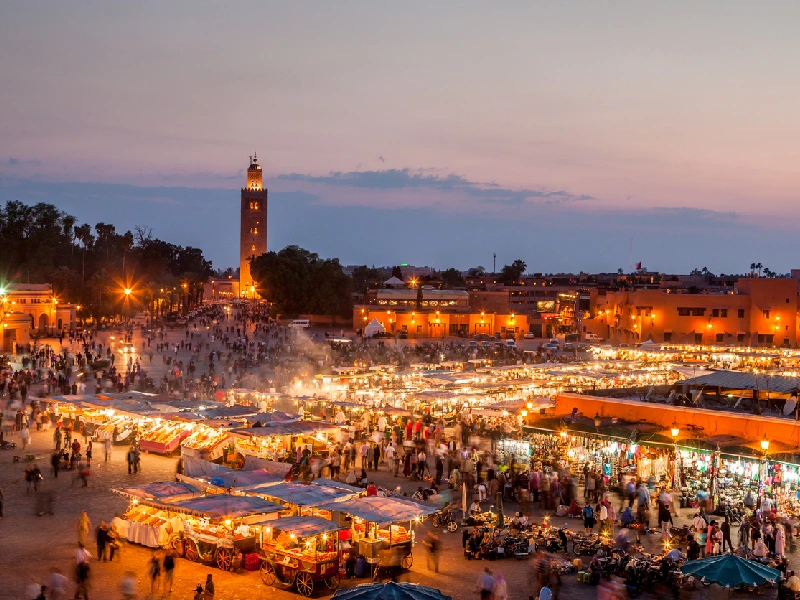
Botanical Sanctuary and Artistic Legacy
Jacques Majorelle's two-and-a-half-acre of horticultural magnificence "features carefully selected flora with rare cacti and exotic plantings at the artist’s direction. The cobalt blue buildings that define the garden present striking chromatic contrast against the terra cotta country. The acquisition and restoration" of the botanical gem by Yves Saint Laurent preserved a valuable cultural treasure, now accompanied by the neighboring Berber Museum and Yves Saint Laurent Museum.
Ancient Rituals of Purification
Hammam is among the oldest wellness traditions of Islam, blending spiritual cleansing with social intercourse across gender-segregated spas. The traditional cleansing ritual follows precise ritualistic guidelines: initial relaxation in warm rooms, exfoliation with age-old black soap produced from olive oil and eucalyptus, intense scrubbing with kessa mitts, and concluding argan oil massage therapy.
Elevated Gastronomy and Panoramic Beauty
Marrakech rooftop dining scene exploits the city's beautiful skyline, offering elevated perspectives of architectural icons against Atlas Mountain scenery. El Fenn offers secluded views of Koutoubia Mosque with creative cuisine including minced lamb paired with honeyed goat cheese. Safran Rooftop Restaurant offers experiential cultural entertainment with its fusion of classic music, belly dancing, and interactive dining ceremonies. Nobu Rooftop Garden introduces cutting-edge beach club chic with Japanese culinary excellence, while Kabana enjoys the distinction of the highest point of the medina.
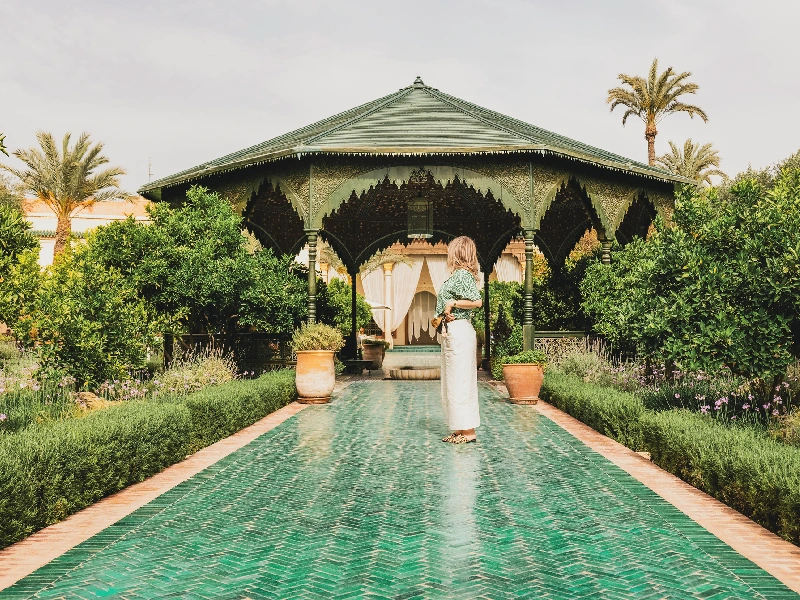
The Gastronomic Heritage of Imperial Marrakech
Marrakech cuisine is an expression of centuries of refined gastronomic artistry, where conventional cooking techniques and artful spice blending developed into a cuisine that defines Moroccan identity. Each preparation involves generations of experience, passed down from generation to generation, which refined these complex flavors throughout centuries.
Medieval Masterpieces of Marrakech Cuisine
At the heart of Marrakech cooking lies slow, patient cooking that achieves unrivaled richness. The defining dish, the tagine, named after its terra cotta pot, uses steam circulation to infuse proteins with saffron, cumin, and ginger. Tangia, a specialty of Marrakech, involves sealing meat in terracotta pots and slow-cooking under hammam ashes to achieve exceptional tenderness.
Couscous exemplifies Moroccan kitchen accuracy—hand-rolled semolina grains steamed multiple times to perfect tenderness, traditionally on Friday evenings. The mythical mechoui of Mechoui Alley uses ancient roasting in underground clay, producing lamb so tender it falls from the bone.
Pastilla stands out in Morocco’s pastry tradition, paper-thin warqa dough sheets filled with spiced poultry, ground almonds, and spices, dusted with sugar and cinnamon for a refined sweet-savory experience.
Culinary Venues: From Tradition to Innovation
In the evening, Jemaa el-Fnaa becomes a vast open-air kitchen buzzing with vendor generations that offer polished recipes. Juice stalls prepare nourishing avocado mixtures made from milk, almonds, and dates—flavorful mixes rooted in nutritional wisdom. Medina cafes offer such staples as harira, the long-cooked richly spiced tomato-lentil soup, and briouats.
The Sacred Ritual of Atay
Morocco's atay, the tea ceremony is not simply a drink; it's an act of generosity. Prepared with fresh mint and poured from above to create foam, the tea comes from three symbolic cups: the bitter one (life), then the sweet one (love), and finally the mellow one (death). Served usually with chebakia, dainty honey-glazed pastries, this everyday ritual shows how food conveys identity, generosity, and belonging.
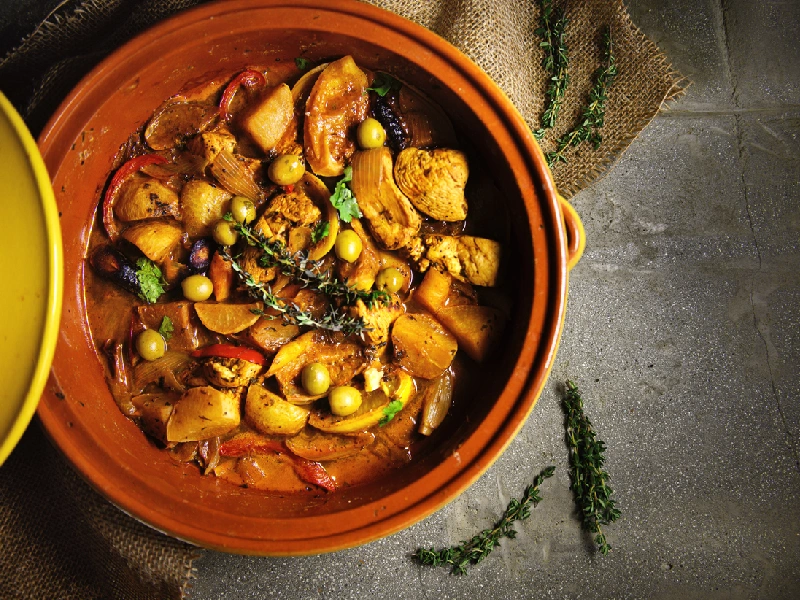
Travel Tips You Need to Know
Successful exploration of the imperial city requires cautious respect for seasonal traditions, cultural etiquette, and practical considerations that serve to heighten appreciation for its historic grandeur.
Best times to visit Marrekch
Climatic study indicates spring (March-May) and autumn (September-November) as the most suitable periods for large-scale archaeological and architectural exploration. May is considered the ideal month with minimal rainfall of 11 mm compared to March's huge 31 mm.
Summer months typically record over 40°C (104°F) temperatures, making them unsuitable for extended exploration of the medina. The winter months (December-February) provide mild daytime temperatures between 18°C and 22°C but nights can be extremely cold, requiring adequate thermal layers. Prepare in advance to make the most of your trip.
Cultural Appropriate and Local Dress Requirements
Respectful dress demonstrates awareness of Islamic cultural sensitivity and provides for appropriate interaction with local populations. Female travelers need to have shoulder, knee, and décolletage coverage in the form of:
- Breathable natural fibers such as cotton or linen that provide comfort while maintaining modesty
- Versatile scarves or pashminas suitable for religious site protocols
- Sturdy closed-toe footwear appropriate for ancient cobblestone pathways
Male visitors benefit from knee-length or longer garments, avoiding revealing attire. Evening venues and refined establishments warrant long trousers and collared shirts for appropriate presentation.
Frequently Asked Questions
Q1. Why is Marrakesh so famous?
Marrakech is famous for its vibrant souks, historic palaces, and the lively Jemaa el-Fnaa square—key highlights among the many things to do in Marrakech.
Q2. Is 3 days enough for Marrakech?
Yes, 3 days is enough to explore the top things to do in Marrakech, including the medina, palaces, gardens, and local cuisine.
Q3. What is Marrakech known for?
Marrakech is known for its red-hued architecture, bustling markets, traditional hammams, and rich cultural heritage.
Q4. What is the best season to visit Marrakech?
Spring (March–May) and autumn (September–November) are the best seasons to visit Marrakech due to pleasant weather for sightseeing.
Q5. What is the national dish of Marrakech?
The national dish of Marrakech is tagine, a slow-cooked stew often made with lamb, vegetables, and fragrant spices.
Ready to discover Morocco's magic? Explore our Morocco Travel Packages and enjoy the best of Middle East trips!

